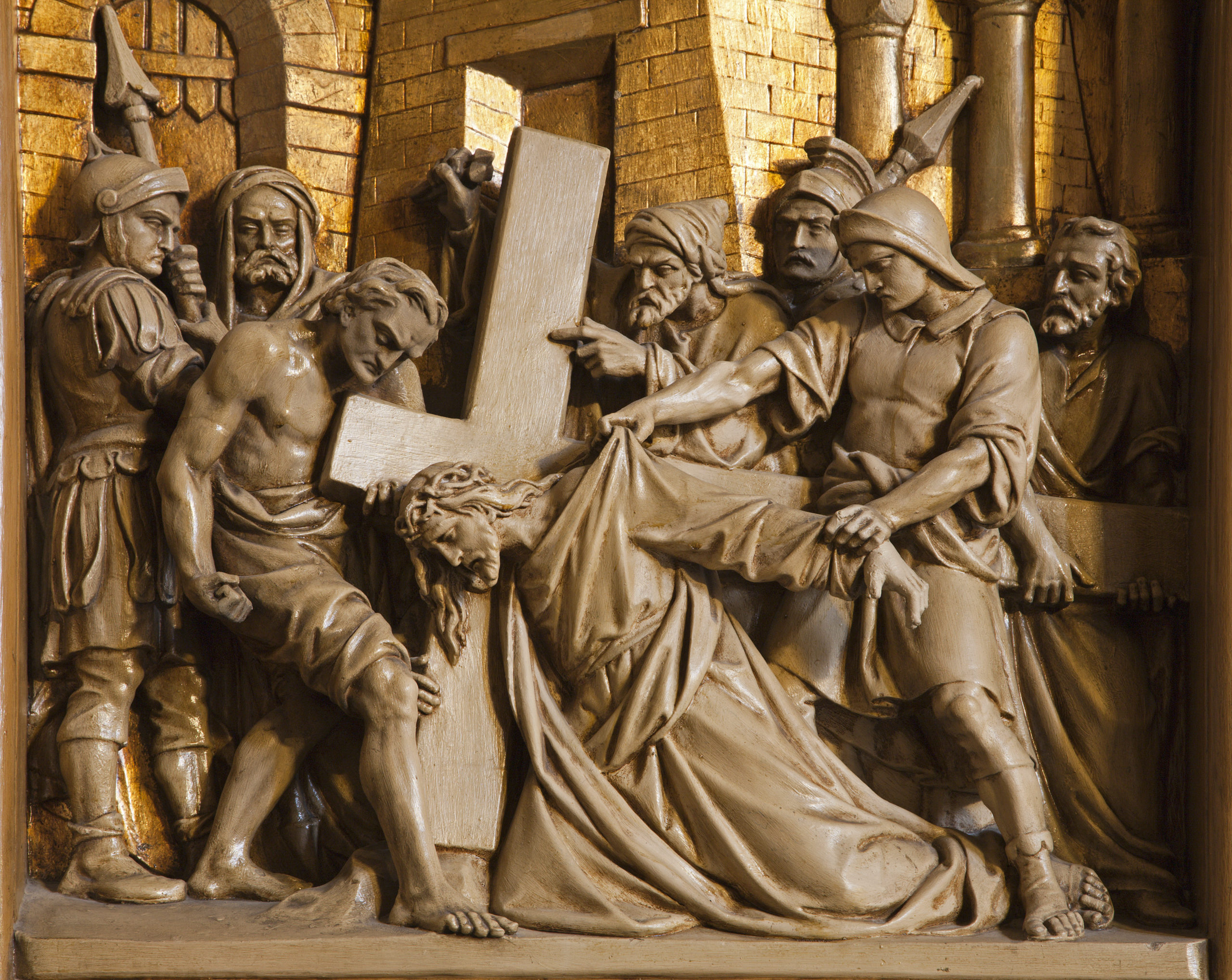
The Stations of the Cross
In the Catholic Church, devotions during the Lenten Season customarily focus on the events of the Passion of Christ. We remember the suffering and death of Jesus, from the agony in the Garden of Gethsemane to his arrest, trial, and crucifixion. One devotion that is popular with many Christians during Lent is the Stations of the Cross, also known as the Way of the Cross.
The Stations of the Cross has its origins in the Middle Ages, when pilgrims were drawn to the Holy Land to retrace Jesus’ footsteps. They visited historical sites in and around Jerusalem related to Holy Thursday and Good Friday events: the Mount of Olives and Gethsemane, site of Jesus’ agony in the Garden; Mount Zion, site of the Last Supper and Caiaphas’ house; the praetorium and Antonia fortress, site of the Roman garrison, where Jesus was tried and condemned; and Calvary, site of the Crucifixion and Jesus’ burial tomb, upon which a Church of the Holy Sepulchre had stood since AD 335, except during periods of special persecution and destruction of the Church and other holy sites by periodic Moslem rulers.
In the mid-1300s, Pope Clement VI named the Franciscans as the official custodians of the Holy Land, and the friars began providing tours of the Via Dolorosa, the street in the Old City of Jerusalem believed to be the path Jesus walked on his way to Calvary. By the fifteenth century outdoor shrines were built throughout Europe to imitate the locations in Jerusalem. Each shrine, or station, represented a Scriptural or traditional scene from Good Friday events. By the mid-1800s, the Stations of the Cross were allowed in churches.
Originally, the number of stations varied from five to twenty. In 1731, Pope Clement XII fixed the number to fourteen. The stations are:
- Jesus is condemned to death
- Jesus carries his cross
- Jesus falls the first time
- Jesus meets his mother
- Simon of Cyrene helps Jesus carry the cross
- Veronica wipes the face of Jesus
- Jesus falls the second time
- Jesus meets the women of Jerusalem
- Jesus falls the third time
- Jesus is stripped of his garments
- Jesus is nailed to the cross
- Jesus dies on the cross
- Jesus is taken down from the cross
- Jesus is laid in the tomb
As only nine of the stations are mentioned in the Gospels—3, 4, 6, 7, and 9 are not attested to in Scripture—in 1991 Pope John Paul II introduced the Scriptural Way of the Cross with the aim of more closely aligning the stations with biblical accounts. This new form of devotion was approved by Pope Benedict XVI in 2007, but a change from the older form is not required, and the older form is most commonly encountered.
- Jesus in the Garden of Gethsemane
- Jesus is betrayed by Judas ad arrested
- Jesus is condemned by the Sanhedrin
- Jesus is denied by Peter
- Jesus is judged by Pilate
- Jesus is scourged and crowned with thorns
- Jesus takes up his cross
- Jesus is helped by Simon of Cyrene to carry his cross
- Jesus meets the women of Jerusalem
- Jesus is crucified
- Jesus promises his kingdom to the repentant thief
- Jesus entrusts Mary and John to each other
- Jesus dies on the cross
- Jesus is laid in the tomb
Some additional thoughts on the Way of the Cross: Upon Jesus’ conviction by the Sanhedrin, he was led bound to the praetorium, then located at the Antonia fortress. Some writers claim that Jesus was taken to Pilate at the site of Herod the Great’s palace—which served as the seat of Roman administration and the normal residence of the Roman governor—rather than to the Antonia. However, the most dangerous times for a possible insurrection were during the major feasts such as Passover, when Jerusalem swelled with crowds of pilgrims. It is highly likely that Pilate moved to the Antonia during such times, both for security and to be in direct control of the Roman garrison, which was quartered there. Activities at the praetorium, such as scourging convicts and jailing the condemned, accord better with a fortress containing barracks than with a residential and administrative palace.
Also, in the first century the configuration of Jerusalem differed greatly from the walled city we see today. In Jesus’ time the wall to the west of the Antonia was much closer to it than either a later Roman wall or today’s wall. Once through the gate, walking west, there was a small rise on the side of the road called Golgotha, “the place of a skull,” whether from something in its appearance or in its history, we do not know. It had the advantages of proximity to the gate, so it was not far to take criminals up the gentle incline to the permanent posts on which they and their crosses would be raised. The total distance from the Antonia to Golgotha was about 1,000 yards.
NOTE: For reference purposes, the stations that do have Scriptural foundations are as follows:
- Jesus is condemned to death Mt 27:26, Mk 15:15, Lk 23:25, Jn 19:16
- Jesus carries his cross Jn 19:17
- Simon of Cyrene helps Jesus carry the cross Mt 27:32, Mk 15:21, Lk 23:26
- Jesus meets the women of Jerusalem Lk 23:27-30
- Jesus is stripped of his garments Mt 27:28
- Jesus is nailed to the cross (Implied)
- Jesus dies on the cross Mt 27:50, Mk 15:37, Lk 23:46, Jn 19:30
- Jesus is taken down from the cross Mt 27:59, Mk 15:46, Lk 23:53, Jn 19:38
- Jesus is laid in the tomb Mt 27:59, Mk 15:46, Lk 23:53, Jn 19:41
